Papers by Dr Anastassia Angelopoulou
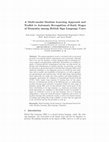
Computer Vision – ECCV 2020 Workshops
The ageing population trend is correlated with an increased prevalence of acquired cognitive impa... more The ageing population trend is correlated with an increased prevalence of acquired cognitive impairments such as dementia. Although there is no cure for dementia, a timely diagnosis helps in obtaining necessary support and appropriate medication. Researchers are working urgently to develop effective technological tools that can help doctors undertake early identification of cognitive disorder. In particular, screening for dementia in ageing Deaf signers of British Sign Language (BSL) poses additional challenges as the diagnostic process is bound up with conditions such as quality and availability of interpreters, as well as appropriate questionnaires and cognitive tests. On the other hand, deep learning based approaches for image and video analysis and understanding are promising, particularly the adoption of Convolutional Neural Network (CNN), which require large amounts of training data. In this paper, however, we demonstrate novelty in the following way: a) a multi-modal machine learning based automatic recognition toolkit for early stages of dementia among BSL users in that features from several parts of the body contributing to the sign envelope, e.g., hand-arm movements and facial expressions, are combined, b) universality in that it is possible to apply our technique to users of any sign language, since it is language independent, c) given the trade-off between complexity and accuracy of machine learning (ML) prediction models as well as the limited amount of training and testing data being available, we show that our approach is not over-fitted and has the potential to scale up.
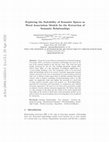
ArXiv, 2020
Given the recent advances and progress in Natural Language Processing (NLP), extraction of semant... more Given the recent advances and progress in Natural Language Processing (NLP), extraction of semantic relationships has been at the top of the research agenda in the last few years. This work has been mainly motivated by the fact that building knowledge graphs (KG) and bases (KB), as a key ingredient of intelligent applications, is a never-ending challenge, since new knowledge needs to be harvested while old knowledge needs to be revised. Currently, approaches towards relation extraction from text are dominated by neural models practicing some sort of distant (weak) supervision in machine learning from large corpora, with or without consulting external knowledge sources. In this paper, we empirically study and explore the potential of a novel idea of using classical semantic spaces and models, e.g., Word Embedding, generated for extracting word association, in conjunction with relation extraction approaches. The goal is to use these word association models to reinforce current relatio...
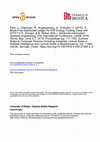
Advanced Information Systems Engineering, 2019
Across the world, the organisation and operation of the electricity markets is quickly changing, ... more Across the world, the organisation and operation of the electricity markets is quickly changing, moving towards decentralised, distributed, renewables-based generation with real-time data exchange-based solutions. In order to support this change, blockchain-based distributed ledgers have been proposed for implementation of peer-to-peer energy trading platform. However, blockchain solutions suffer from scalability problems as well as from delays in transaction confirmation. This paper explores the feasibility of using IOTA's DAG-based block-free distributed ledger for implementation of energy trading platforms. Our agent-based simulation research demonstrates that an IOTA-like DAG-based solution could overcome the constraints that blockchains face in the energy market. However, to be usable for peer-to-peer energy trading, even DAGbased platforms need to consider specificities of energy trading markets (such as structured trading periods and assured confirmation of transactions for every completed period). Keywords: blockchain • peer to peer energy trading platform • DAGbased distributed ledger • block-free ledger • IOTA • agent-based simulation.
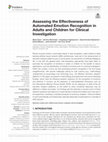
Frontiers in Human Neuroscience, 2020
Recent success stories in automated object or face recognition, partly fuelled by deep learning a... more Recent success stories in automated object or face recognition, partly fuelled by deep learning artificial neural network (ANN) architectures, have led to the advancement of biometric research platforms and, to some extent, the resurrection of Artificial Intelligence (AI). In line with this general trend, inter-disciplinary approaches have been taken to automate the recognition of emotions in adults or children for the benefit of various applications, such as identification of children's emotions prior to a clinical investigation. Within this context, it turns out that automating emotion recognition is far from being straightforward, with several challenges arising for both science (e.g., methodology underpinned by psychology) and technology (e.g., the iMotions biometric research platform). In this paper, we present a methodology and experiment and some interesting findings, which raise the following research questions for the recognition of emotions and attention in humans: (a) the adequacy of well-established techniques such as the International Affective Picture System (IAPS), (b) the adequacy of state-of-the-art biometric research platforms, (c) the extent to which emotional responses may be different in children and adults. Our findings and first attempts to answer some of these research questions are based on a mixed sample of adults and children who took part in the experiment, resulting in a statistical analysis of numerous variables. These are related to both automatically and interactively captured responses of participants to a sample of IAPS pictures.
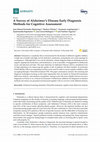
Sensors, 2020
Dementia is a syndrome that is characterised by the decline of different cognitive abilities. A h... more Dementia is a syndrome that is characterised by the decline of different cognitive abilities. A high rate of deaths and high cost for detection, treatments, and patients care count amongst its consequences. Although there is no cure for dementia, a timely diagnosis helps in obtaining necessary support, appropriate medication, and maintenance, as far as possible, of engagement in intellectual, social, and physical activities. The early detection of Alzheimer Disease (AD) is considered to be of high importance for improving the quality of life of patients and their families. In particular, Virtual Reality (VR) is an expanding tool that can be used in order to assess cognitive abilities while navigating through a Virtual Environment (VE). The paper summarises common AD screening and diagnosis techniques focusing on the latest approaches that are based on Virtual Environments, behaviour analysis, and emotions recognition, aiming to provide more reliable and non-invasive diagnostics at h...
Computational Intelligence and Neuroscience, 2019
Neural Computing and Applications, 2016
This work presents the design of a real-time system to model visual objects with the use of selfo... more This work presents the design of a real-time system to model visual objects with the use of selforganising networks. The architecture of the system addresses multiple computer vision tasks such as image segmentation, optimal parameter estimation and object representation. We first develop a framework for building non-rigid shapes using the growth mechanism of the selforganising maps, and then we define an optimal number of nodes without overfitting or underfitting the network based on the knowledge obtained from information-theoretic considerations. We present experimental results for hands and faces, and we quantitatively evaluate the matching capabilities of the proposed method with the topographic product. The proposed method is easily extensible to 3D objects, as it offers similar features for efficient mesh reconstruction.
Communications in Computer and Information Science, 2014
Commonplace objects are being redesigned with digital functionality. Near invisible networks of r... more Commonplace objects are being redesigned with digital functionality. Near invisible networks of radio frequency identification tags (RFID) are being deployed on almost every type of consumer product, and the "Ambient intelligence" promises to form a global network of physical objects as ubiquitous as the worldwide web itself. This diverse global network, "the internet of things" (IoT), provides digital connectivity on top of existing infrastructure and items. Nascent "smart object" developments like the presented "UCF Smart Mailbox," not only reformulate our relationship with the objects themselves, but they can also support social relationships that contribute to the sustainability of the society.
New Trends in Image Analysis and Processing - ICIAP 2013. ICIAP 2013 International Workshops. Proceedings: LNCS 8158, 2013
This paper presents the integration of human-machine interaction technologies within a virtual re... more This paper presents the integration of human-machine interaction technologies within a virtual reality environment to allow for real-time manipulation of 3D objects using different gestures. We demonstrate our approach by developing a fully operational, natural user interface (NUI) system, which provides a front-end framework for back-end applications that use more traditional forms of input, such as wear cable sensors attached to the users. The implementation is a user-friendly system that has immense potential in a number of fields, especially in the medical sciences where it would be possible to increase the productivity of surgeons by providing them with easy access to relevant MRI scans.
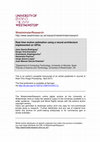
This work describes a neural network based architecture that represents and estimates object moti... more This work describes a neural network based architecture that represents and estimates object motion in videos. This architecture addresses multiple computer vision tasks such as image segmentation, object representation or characterization, motion analysis and tracking. The use of a neural network architecture allows for the simultaneous estimation of global and local motion and the representation of deformable objects. This architecture also avoids the problem of finding corresponding features while tracking moving objects. Due to the parallel nature of neural networks, the architecture has been implemented on GPUs that allows the system to meet a set of requirements such as: time constraints management, robustness, high processing speed and re-configurability. Experiments are presented that demonstrate the validity of our architecture to solve problems of mobile agents tracking and motion analysis.
Lecture Notes in Computer Science, 2011
This paper aims to address the ability of self-organizing neural network models to manage video a... more This paper aims to address the ability of self-organizing neural network models to manage video and image processing in real-time. The Growing Neural Gas networks (GNG) with its attributes of growth, flexibility, rapid adaptation, and excellent quality representation of the input space makes it a suitable model for real time applications. A number of applications are presented that includes: image compression, hand and medical image contours representation, surveillance systems, hand gesture recognition systems or 3D data reconstruction.
Studies in Computational Intelligence, 2012
The use of general descriptive names, registered names, trademarks, etc. in this publication does... more The use of general descriptive names, registered names, trademarks, etc. in this publication does not imply, even in the absence of a specific statement, that such names are exempt from the relevant protective laws and regulations and therefore free for general use.
Active -GNG
Proceedings of the 1st ACM workshop on Vision networks for behavior analysis, 2008
The Self-Organising Artificial Neural Network Models, of which we have used the Growing Neural Ga... more The Self-Organising Artificial Neural Network Models, of which we have used the Growing Neural Gas (GNG) can be applied to preserve the topology of an input space. Traditionally these models neither do include local adaptation of the nodes nor colour information. In this paper, we extend GNG by adding an active step to the network, which we call Active-Growing Neural
Hand gesture modelling and tracking using a Self-Organising Network
The 2010 International Joint Conference on Neural Networks (IJCNN), 2010
AbstractThe Self-Organising Artificial Neural Network Models, of which we have used the Growing ... more AbstractThe Self-Organising Artificial Neural Network Models, of which we have used the Growing Neural Gas (GNG) can be applied to preserve the topology of an input distribution. Traditionally these models neither do include local adaptation of the nodes nor colour information. In ...

Region analysis through close contour transformation using growing neural gas
The 2012 International Joint Conference on Neural Networks (IJCNN), 2012
ABSTRACT In our work we aim to explore a general framework that addresses the fundamental problem... more ABSTRACT In our work we aim to explore a general framework that addresses the fundamental problem of universal unsuper-vised extraction of semantically meaningful visual regions. To this end this paper describes a novel region analysis technique using a self-organising map, the growing neural gas, which is adapted so as to improve modelling speed as well as to ensure a double-linkage chain around all region contours to simplify shape analysis. While the growing neural gas has been extensively applied to shape modelling, it has never explicitly been used for curvature analysis, contour description and region similarity. Once a contour network has been obtained, a transformation is applied that converts the closed contour to an open one, facilitating the use of certain angular descriptors. Discriminative descriptors derived from the properties of regions, their contours and their transformed contours are established and define a feature vector used for the representation of regions based on the appearance and contour information.
Automatically Building 2D Statistical Shapes Using the Topology Preservation Model GNG
Lecture Notes in Computer Science, 2006
Image segmentation is very important in computer based image interpretation and it involves the l... more Image segmentation is very important in computer based image interpretation and it involves the labeling of the image so that the labels correspond to real world objects. In this study, we utilise a novel approach to automatically segment out the ventricular system from a series of MR brain images and to recover the shape of hand outlines from a series
Automatic Landmarking of 2D Medical Shapes Using the Growing Neural Gas Network
Lecture Notes in Computer Science, 2005
MR Imaging techniques provide a non-invasive and accurate method for determining the ultra-struct... more MR Imaging techniques provide a non-invasive and accurate method for determining the ultra-structural features of human anatomy. In this study, we utilise a novel approach to segment out the ventricular system in a series of high resolution T1-weighted MR images. Our approach is based on an automated landmark extraction algorithm which automatically selects points along the contour of the ventricles
Object Representation with Self-Organising Networks
Lecture Notes in Computer Science, 2011
ABSTRACT This paper, aims to address the ability of self-organising networks to automatically ext... more ABSTRACT This paper, aims to address the ability of self-organising networks to automatically extract and correspond landmark points using only topological relations derived from competitive hebbian learning. We discuss, how the Growing Neural Gas (GNG) algorithm can be used for the automatic extraction and correspondence of nodes in a set of objects, which are then used to built statistical human brain MRI and hand gesture models.
Tracking gestures using a probabilistic Self-Organising network
The 2010 International Joint Conference on Neural Networks (IJCNN), 2010
AbstractThe Self-Organising Artificial Neural Network Models, of which we have used the Growing ... more AbstractThe Self-Organising Artificial Neural Network Models, of which we have used the Growing Neural Gas (GNG) can be applied to preserve the topology of an input distribution. Traditionally these models neither do include local adaptation of the nodes nor colour information. In ...

Neural Processing Letters, 2012
Automatic video segmentation plays a vital role in sports videos annotation. This paper presents ... more Automatic video segmentation plays a vital role in sports videos annotation. This paper presents a fully automatic and computationally efficient algorithm for analysis of sports videos. Various methods of automatic shot boundary detection have been proposed to perform automatic video segmentation. These investigations mainly concentrate on detecting fades and dissolves for fast processing of the entire video scene without providing any additional feedback on object relativity within the shots. The goal of the proposed method is to identify regions that perform certain activities in a scene. The model uses some low-level feature video processing algorithms to extract the shot boundaries from a video scene and to identify dominant colours within these boundaries. An object classification method is used for clustering the seed distributions of the dominant colours to homogeneous regions. Using a simple tracking method a classification of these regions to active or static is performed. The efficiency of the proposed framework is demonstrated over a standard video benchmark with numerous types of sport events and the experimental results show that our algorithm can be used with high accuracy for automatic annotation of active regions for sport videos.

Uploads
Papers by Dr Anastassia Angelopoulou